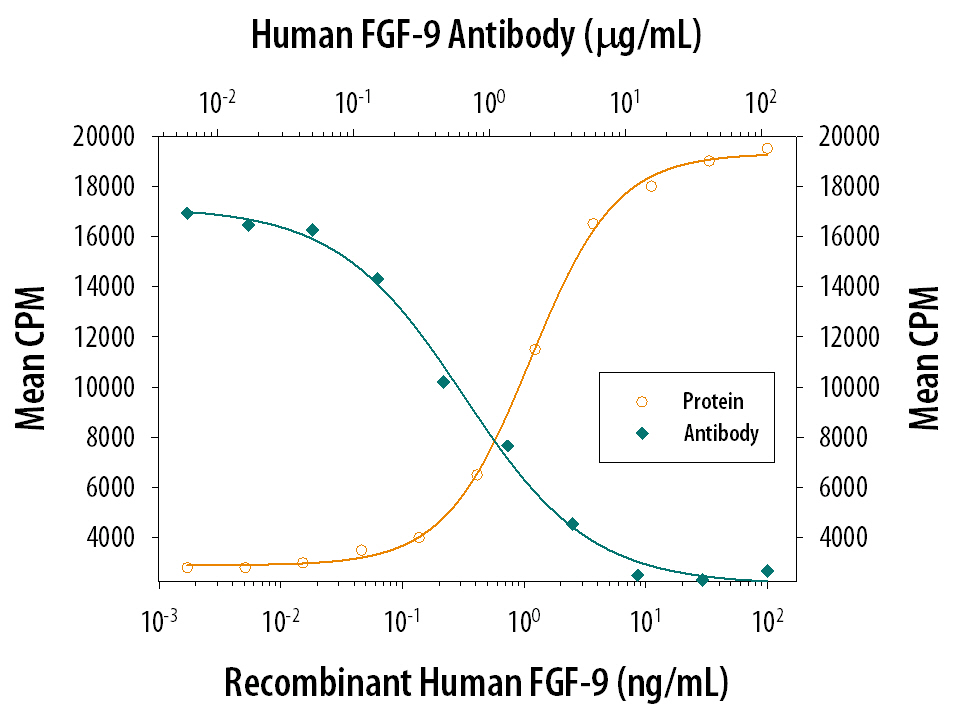Human FGF-9 Antibody Summary
Applications
Human FGF-9 Sandwich Immunoassay
Please Note: Optimal dilutions should be determined by each laboratory for each application. General Protocols are available in the Technical Information section on our website.
Scientific Data
 View Larger
View Larger
Cell Proliferation Induced by FGF‑9 and Neutralization by Human FGF‑9 Antibody. Recombinant Human FGF-9 (Catalog # 273-F9) stimulates proliferation in the Balb/3T3 mouse embryonic fibroblast cell line in a dose-dependent manner (orange line). Proliferation elicited by Recombinant Human FGF-9 (10 ng/mL) is neutralized (green line) by increasing concentrations of Mouse Anti-Human FGF-9 Monoclonal Antibody (Catalog # MAB273). The ND50 is typically 0.1-0.6 µg/mL.
Reconstitution Calculator
Preparation and Storage
- 12 months from date of receipt, -20 to -70 degreesC as supplied. 1 month, 2 to 8 degreesC under sterile conditions after reconstitution. 6 months, -20 to -70 degreesC under sterile conditions after reconstitution.
Background: FGF-9
The FGF family is comprised of at least nine polypeptides that show a variety of biological activities toward cells of mesenchymal, neuronal and epithelial origin. All FGFs have two conserved cysteine residues and share 30-50% sequence identity at the amino acid level. FGF-9, also named glia-activating factor, was originally identified and purified from the supernatant of a human glioma cell line as a heparin-binding mitogenic growth factor for glial cells. FGF-9 has also been shown to stimulate the proliferation of oligodendrocyte type 2 astrocyte progenitor cells, Balb/c3T3 fibroblasts and PC-12 cells. However, unlike FGF acidic and basic, FGF-9 is not a mitogen for human umbilical vein endothelial cells. The human FGF-9 cDNA encodes a 208 amino acid residue protein that contains a potential N-linked glycosylation site. The native protein is glycosylated. FGF-9 exhibits approximately 30% sequence similarity to other members of the FGF family. Although FGF-9 lacks a typical secretion signal, the protein is secreted efficiently after synthesis. Rat FGF-9 cDNA has been cloned and shown to be highly homologous to human FGF-9. The two proteins differ only in one amino acid residue. The expression of the FGF-9 transcripts has been shown to be restricted to the brain and the kidney.
- Naruo, K. et al. (1993) J. Biol. Chem. 268:2857.
- Miyamoto, M. et al. (1993) Mol. Cell Biol. 13:4251.
Product Datasheets
Citations for Human FGF-9 Antibody
R&D Systems personnel manually curate a database that contains references using R&D Systems products. The data collected includes not only links to publications in PubMed, but also provides information about sample types, species, and experimental conditions.
5
Citations: Showing 1 - 5
Filter your results:
Filter by:
-
Three subtypes of lung cancer fibroblasts define distinct therapeutic paradigms.
Authors: Haichuan H, Zofia P, Patricia H et al.
Cancer Cell.
-
FGF9 from cancer-associated fibroblasts is a possible mediator of invasion and anti-apoptosis of gastric cancer cells.
Authors: Sun C, Fukui H, Hara K, Zhang X, Kitayama Y, Eda H, Tomita T, Oshima T, Kikuchi S, Watari J, Sasako M, Miwa H
BMC Cancer, 2015-04-30;15(0):333.
Species: Human
Sample Types: Whole Cells
Applications: Neutralization -
Fibroblast growth factor 9 has oncogenic activity and is a downstream target of Wnt signaling in ovarian endometrioid adenocarcinomas.
Authors: Hendrix ND, Wu R, Kuick R, Schwartz DR, Fearon ER, Cho KR
Cancer Res., 2006-02-01;66(3):1354-62.
Species: Human
Sample Types: Cell Lysates
Applications: Western Blot -
Expression and possible function of fibroblast growth factor 9 (FGF9) and its cognate receptors FGFR2 and FGFR3 in postnatal and adult retina.
Authors: Cinaroglu A, Ozmen Y, Ozdemir A, Ozcan F, Ergorul C, Cayirlioglu P, Hicks D, Bugra K
J. Neurosci. Res., 2005-02-01;79(3):329-39.
Species: Rat
Sample Types: Whole Cells, Whole Tissue
Applications: IHC-P, Neutralization -
Fgf9 induces proliferation and nuclear localization of FGFR2 in Sertoli precursors during male sex determination.
Authors: Schmahl J, Kim Y, Colvin JS, Ornitz DM, Capel B
Development, 2004-06-30;131(15):3627-36.
Species: Human
Sample Types: Recombinant Protein
Applications: IHC
FAQs
No product specific FAQs exist for this product, however you may
View all Antibody FAQsReviews for Human FGF-9 Antibody
There are currently no reviews for this product. Be the first to review Human FGF-9 Antibody and earn rewards!
Have you used Human FGF-9 Antibody?
Submit a review and receive an Amazon gift card.
$25/€18/£15/$25CAN/¥75 Yuan/¥2500 Yen for a review with an image
$10/€7/£6/$10 CAD/¥70 Yuan/¥1110 Yen for a review without an image

